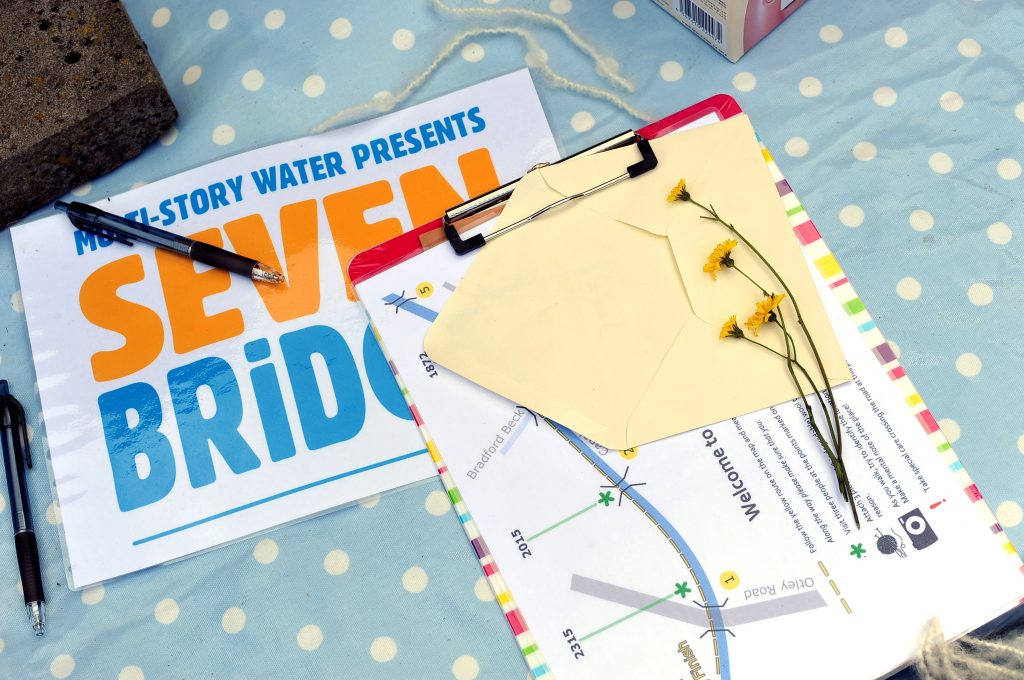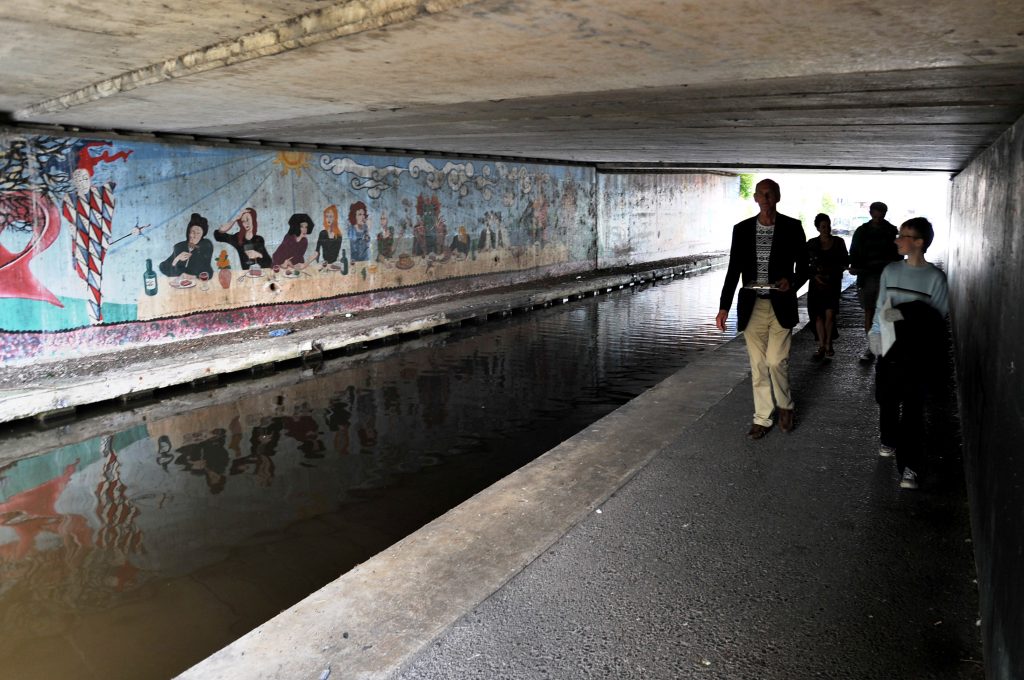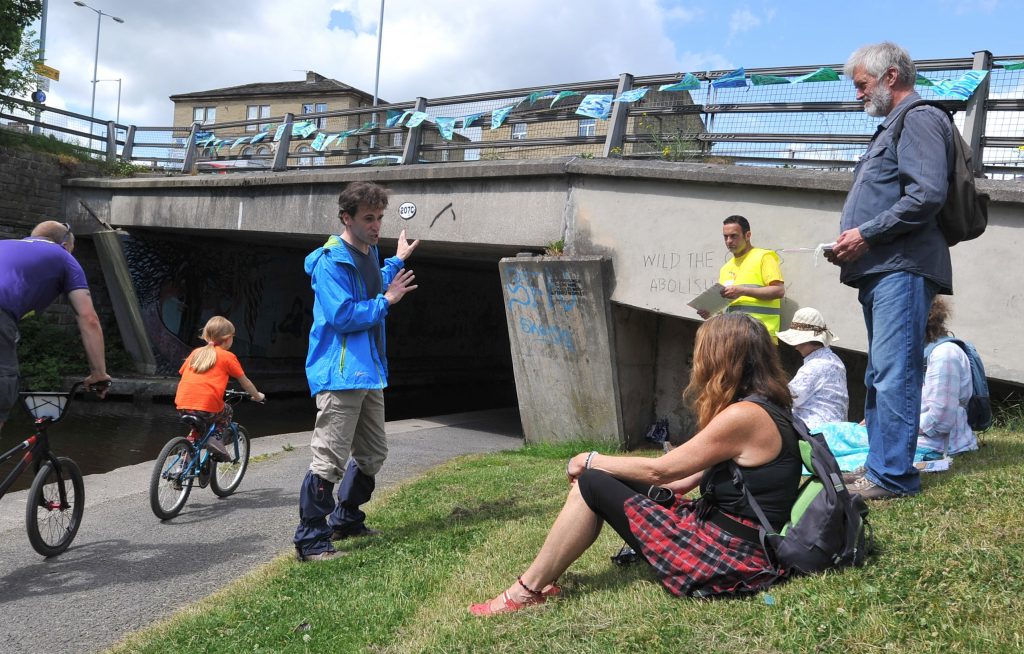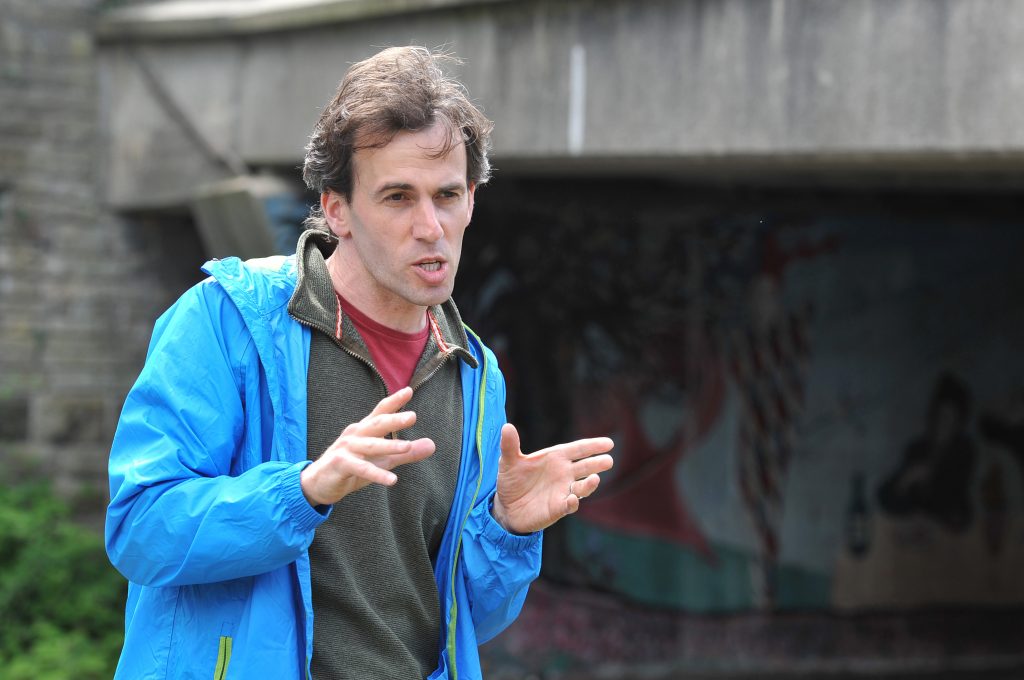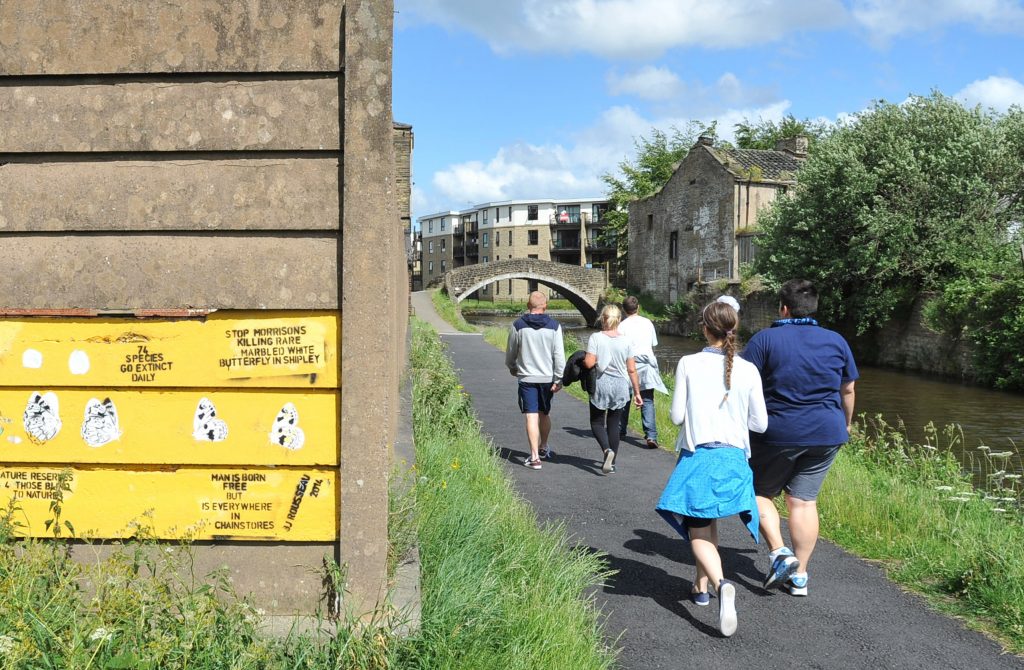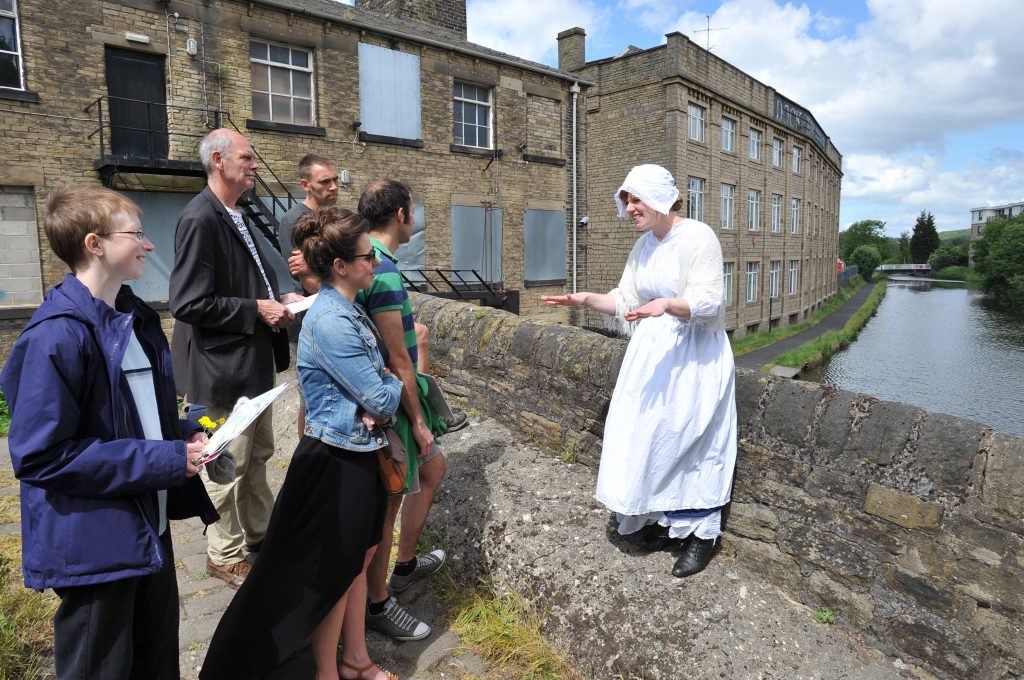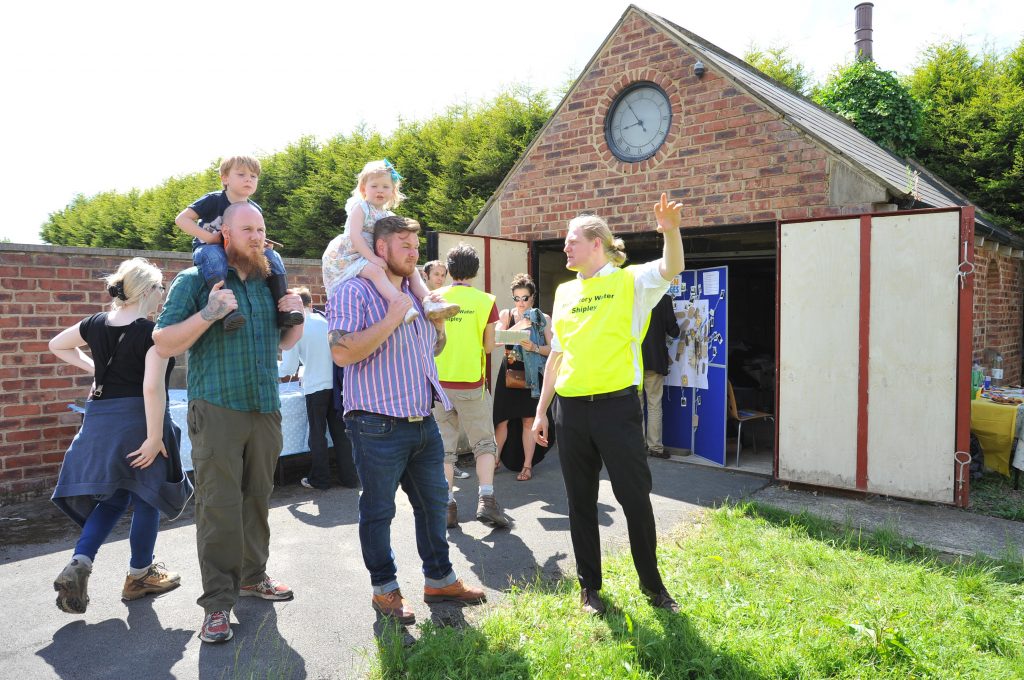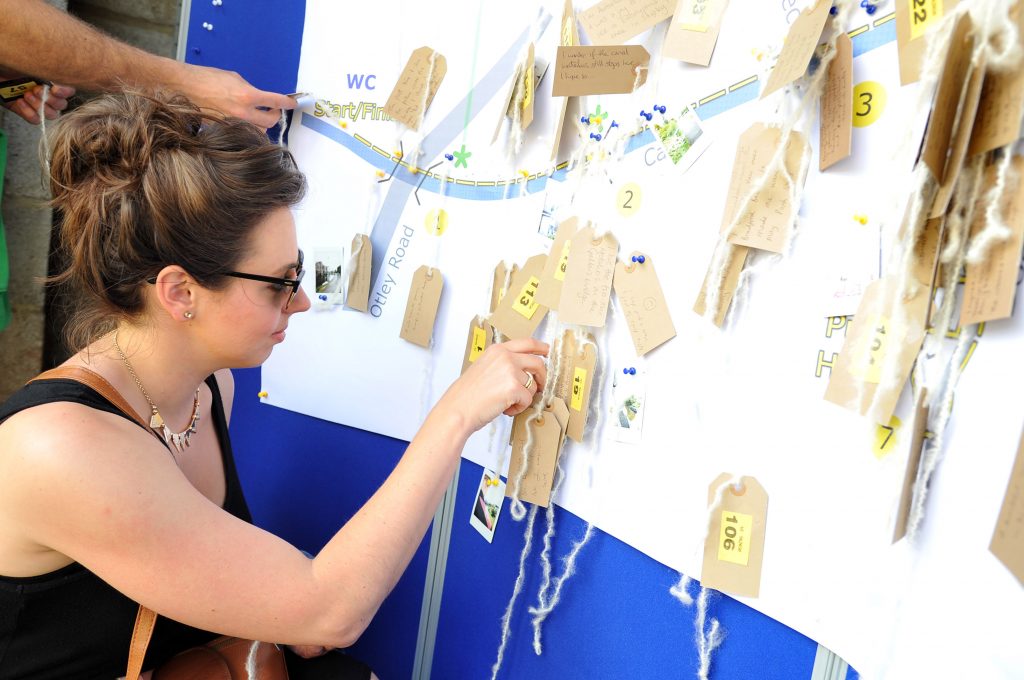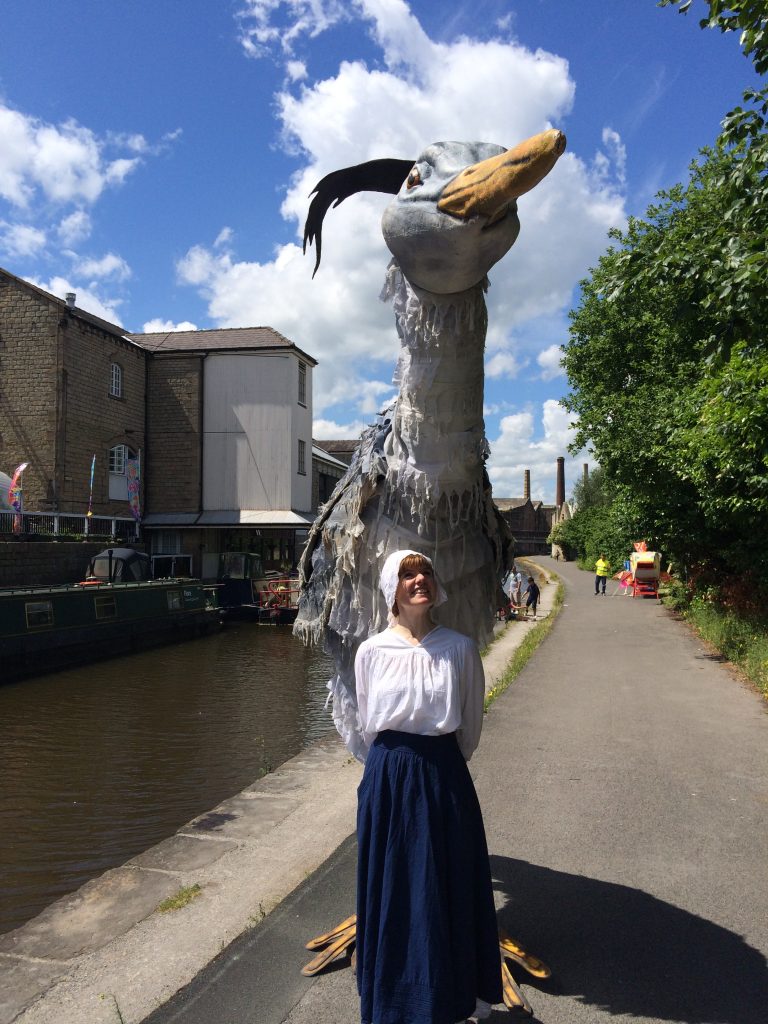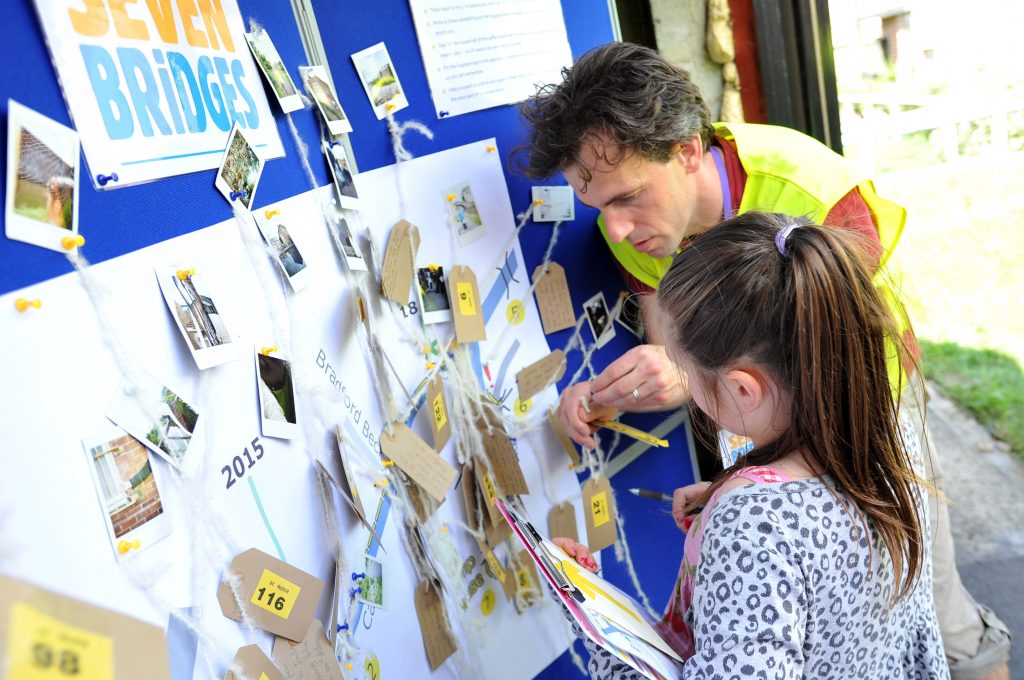 Seven Bridges was a participatory promenade tour along the Leeds-Liverpool Canal in Shipley. It was developed by Multi-Story Water as our key contribution to the Shipley Street Arts Festival of 2015 — and ran on the same weekend as another piece we made with the same title at Leeds Waterfront Festival. These two versions of Seven Bridges provided a conceptual “bridge” between the two Aire valley festivals, 12 miles apart. A blog account of these events is offered here, and MSW’s other contributions to the Street Arts Festival are documented here.
Seven Bridges was a participatory promenade tour along the Leeds-Liverpool Canal in Shipley. It was developed by Multi-Story Water as our key contribution to the Shipley Street Arts Festival of 2015 — and ran on the same weekend as another piece we made with the same title at Leeds Waterfront Festival. These two versions of Seven Bridges provided a conceptual “bridge” between the two Aire valley festivals, 12 miles apart. A blog account of these events is offered here, and MSW’s other contributions to the Street Arts Festival are documented here.
The Shipley version of Seven Bridges drew in part on historical research into the area, and adopted the conceit of operating in three different “time zones” (the future, the present, and the past). At heart, though, the piece was about asking spectators to look around themselves, playfully and thoughtfully. Since Shipley’s seemingly mundane waterside is inevitably less spectacular than our twin Seven Bridges route in Leeds city centre, we invited participants to look at their environment in unexpected ways — to find the magic, if you like, in these everyday spaces…
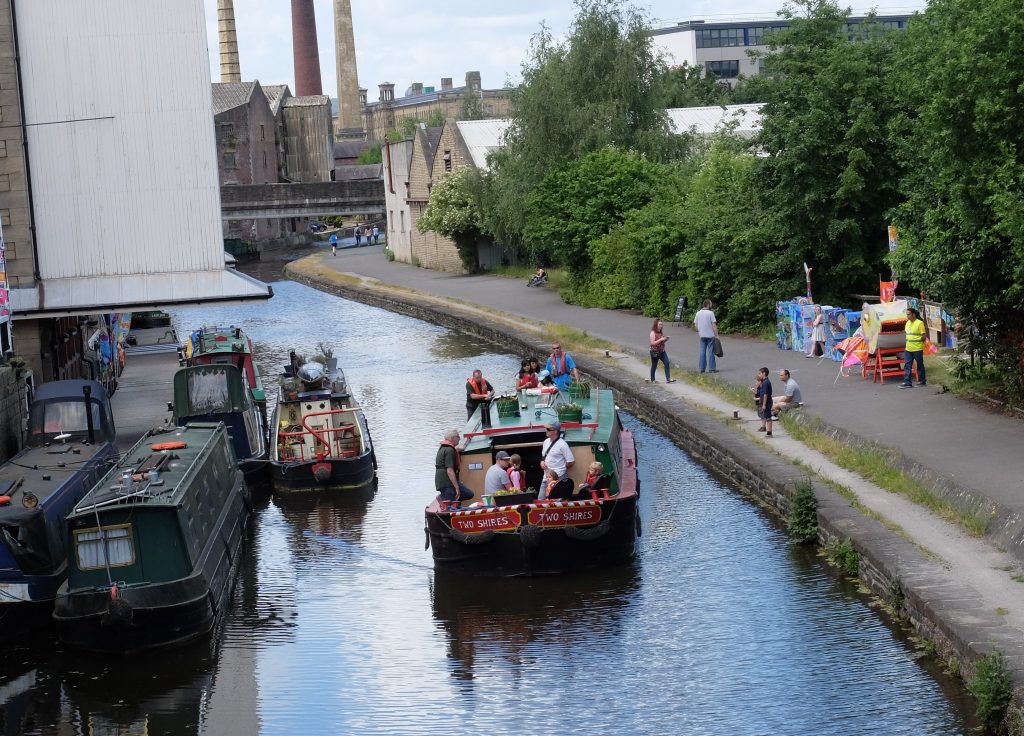 The starting point for Seven Bridges was the same as for our 2012-13 Red Route tours — a spot on the canal towpath opposite Shipley Wharf (outside the Ibis hotel). On this occasion, this spot was also a sub-hub for the Street Arts Festival. Inspired in part by Multi-Story Water’s previous performances, the festival’s organisers — street event specialists Q20 Theatre (who are based nearby, on Dockfield Road) — had decided to take the town’s waterways as the theme for this year’s festival. This also involved, for example, inviting the JAMES organisation to offer boat rides to festival-goers on the Two Shires barge (pictured above). Below, Multi-Story steward Steve Bottoms is pictured in the Ibis forecourt, next to the towpath, with Q20’s giant stork puppet…
The starting point for Seven Bridges was the same as for our 2012-13 Red Route tours — a spot on the canal towpath opposite Shipley Wharf (outside the Ibis hotel). On this occasion, this spot was also a sub-hub for the Street Arts Festival. Inspired in part by Multi-Story Water’s previous performances, the festival’s organisers — street event specialists Q20 Theatre (who are based nearby, on Dockfield Road) — had decided to take the town’s waterways as the theme for this year’s festival. This also involved, for example, inviting the JAMES organisation to offer boat rides to festival-goers on the Two Shires barge (pictured above). Below, Multi-Story steward Steve Bottoms is pictured in the Ibis forecourt, next to the towpath, with Q20’s giant stork puppet…
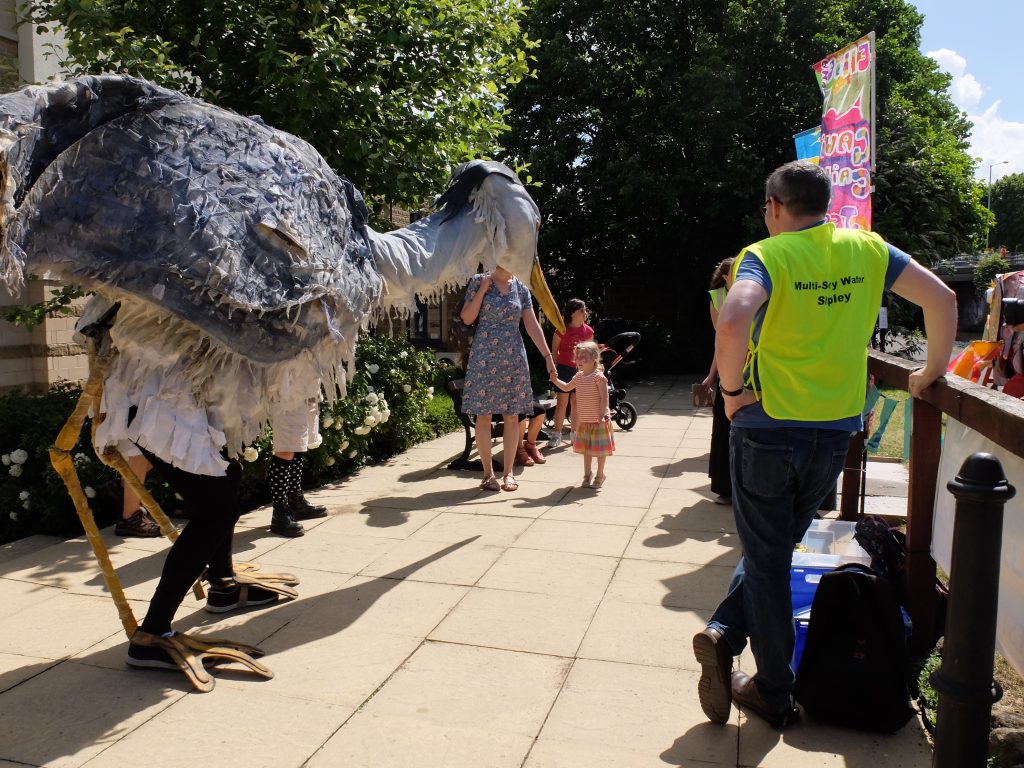 Participants could arrive to undertake the Seven Bridges walk at any time between 11.30 and 2.30pm (peak festival hours), since the experience was repeated at regular intervals. Walkers were assembled into groups of five or six, and provided with clipboards bearing: (1) a simple, schematic map of an eastward route along the canal, and (2) an envelope containing a polaroid-style photograph and three lengths of coarse, biodegradable wool (a nod to Shipley’s history of textile manufacturing).
Participants could arrive to undertake the Seven Bridges walk at any time between 11.30 and 2.30pm (peak festival hours), since the experience was repeated at regular intervals. Walkers were assembled into groups of five or six, and provided with clipboards bearing: (1) a simple, schematic map of an eastward route along the canal, and (2) an envelope containing a polaroid-style photograph and three lengths of coarse, biodegradable wool (a nod to Shipley’s history of textile manufacturing).
Instructions on the map invited participants to undertake the following tasks:
Walking: to self-guide themselves, as a group, along the marked route, via seven bridges.
Knotting: to attach the pieces of wool to any three locations along the way that “resonate with you for some reason”.
Spotting: to try to identify, along the route, the location where the enclosed photograph was taken by a previous audience member.
Armed with these materials, participants set off along the towpath, heading almost immediatedly underneath the first of our seven bridges (the ugly concrete construction that carries the multi-carriageway Otley Road across the canal) and past the decades-old, psychedelic mural on the facing wall. On emerging from under the bridge, they encountered the first of our actors, David Smith… whose greeting and monologue quickly made it apparent that he was “in the future” — 2315 to be exact.
“Welcome. Next weekend the Shipley Canal Heritage site opens to the public, and it’s a pleasure to unveil it to you – our principal funders – today. This is the only surviving section of the once-popular Leeds-Liverpool Canal – and we’ve restored it to how it would have appeared 300 yrs ago, in 2015. This structure is one of the major heritage points along the route – so visitors get a rich experience from the off.
“The noise you hear is – we believe – a faithful reproduction of what you would have heard here in 2015, and is produced by “cars” — the motorised units crossing this “bridge”, which, like much in this environment, is man-made. Cars were the primary mode of transport prior to the advent of affordable teleportation – the noise due to fossil-fuel based combustion engines, which would no longer be legal. These simulations are silent, with the soundscape piped in through concealed speakers.
“We don’t know what the bridge’s official name was, so we call it ‘Arts Bridge’ – reflecting the rich variety of art from multiple disciplines. Here (indicates) is a form of graffiti known as tagging – a rudimentary artform, but clearly important, as archaeological research clearly shows that it was widespread in public locations.
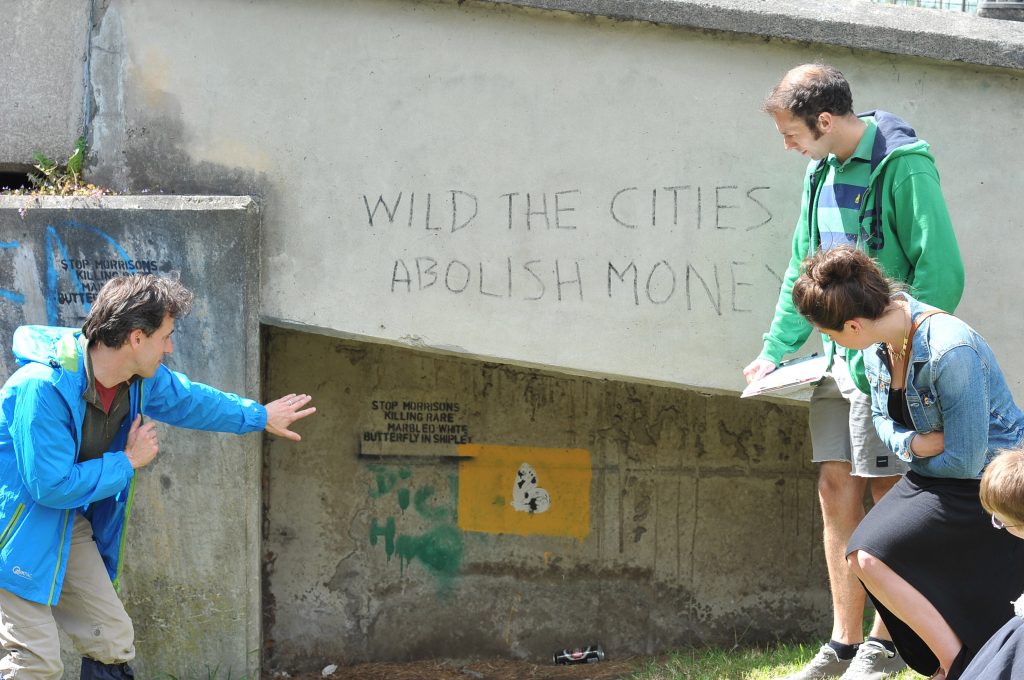
“This piece – STOP MORRISONS KILLING RARE MARBLED WHITE BUTTERFLY seems to have a political motivation, but we’ve yet to uncover who or what ‘Morrisons’ was and why they had taken against the butterfly: research continues. . . Here: WILD THE CITIES ABOLISH MONEY seems to relate directly to the bridge structure. Ironically, we have gone to great lengths to recreate the road, as so few have survived – this was a stretch of scrubland before we got to work on it.
But the most prominent art work is under the bridge itself. What does it represent? Who painted it? We’re not sure, although accounts of the time attribute it to graduate art students, painting it in defiance of the local authorities. This facsimile accurately reflects the state of degradation that this piece had fallen into by 2015 – due in part to the failure of public authorities to preserve this work of clear artistic merit and partly because this bridge formed an excellent habitat for the “rock dove” or “pigeon”: the visible vertical striations actually created by the excrement from the rock dove as it roosted. Rock doves are now, sadly, extinct in the wild. The simulations you see flying around the heritage site are very advanced, but fall short of producing excrement. The “excrement” on the artwork may be 100% chemically identical to the original, but it was created in the lab and painted on by skilled artists. There’s plenty more to see – I’ll won’t hold you up any longer – enjoy.” (Text by David Smith)
From here, walkers continued east along the canal… as they meandered, they tied pieces of wool to everything from bars across a window to canalside weeds plants… until encountering a second performer, Simon Brewis, underneath our second bridge, the early Victorian Gallows Bridge (so-named for its right-angled cross-frame).
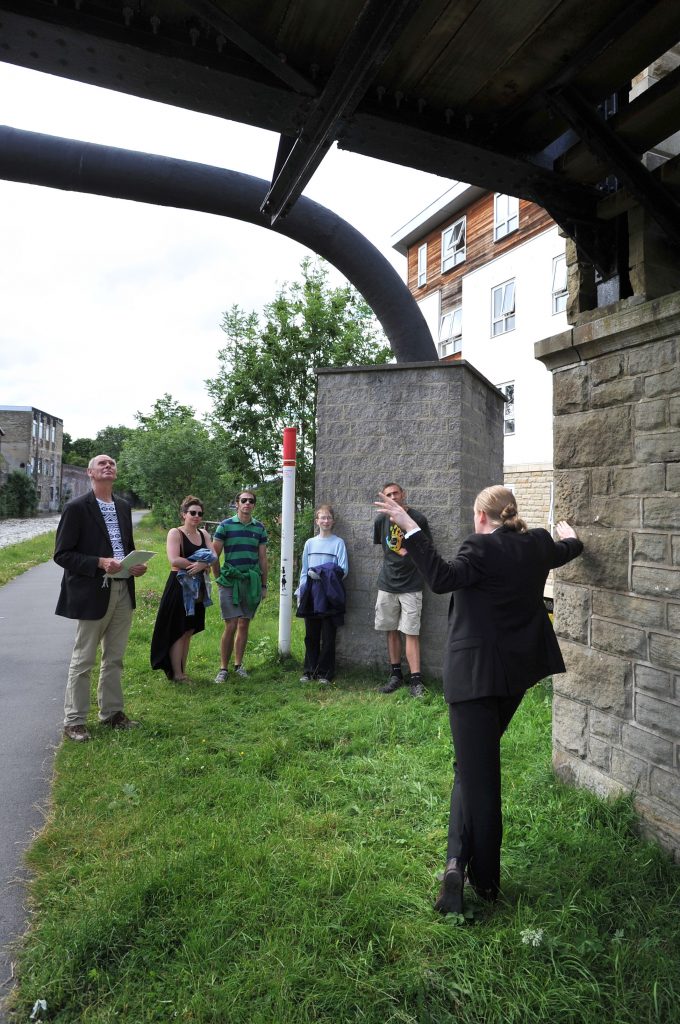 Simon is from the present day. 2015. But as he explains to his audience, he’s concerned with both the past and the future. He works for the Canal and River Trust, he tells us, which was only founded three years ago, in 2012 — when the government turned British Waterways into a new, charitable trust. He and his colleagues, Simon points out, are the custodians of a big chunk of English heritage — this 126-mile long canal and many of its surrounding structures, such as this bridge… But in order to preserve this rich heritage for future generations, the Trust now needs to find members and volunteers to help and support its work, as central government withdraws funding…
Simon is from the present day. 2015. But as he explains to his audience, he’s concerned with both the past and the future. He works for the Canal and River Trust, he tells us, which was only founded three years ago, in 2012 — when the government turned British Waterways into a new, charitable trust. He and his colleagues, Simon points out, are the custodians of a big chunk of English heritage — this 126-mile long canal and many of its surrounding structures, such as this bridge… But in order to preserve this rich heritage for future generations, the Trust now needs to find members and volunteers to help and support its work, as central government withdraws funding…
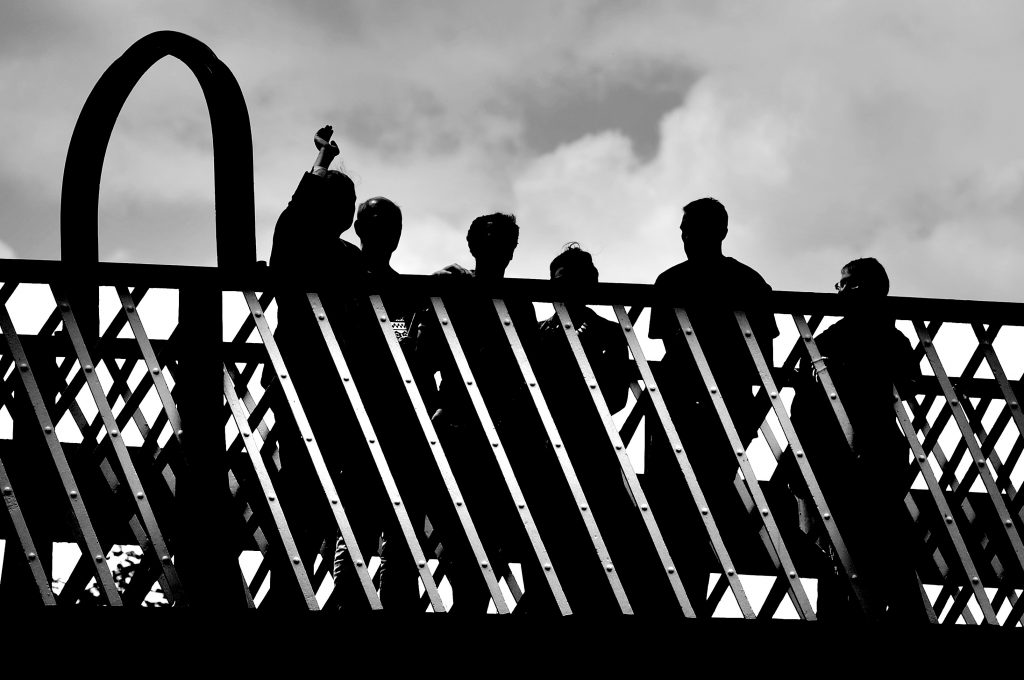 Taking visitors up onto this iron-framed bridge to look out along the canal, Simon points out what a remarkable piece of engineering it is… What they see ahead of them is in fact an aqueduct (our third bridge!), which carries the canal clear over Bradford Beck, flowing underneath…
Taking visitors up onto this iron-framed bridge to look out along the canal, Simon points out what a remarkable piece of engineering it is… What they see ahead of them is in fact an aqueduct (our third bridge!), which carries the canal clear over Bradford Beck, flowing underneath…
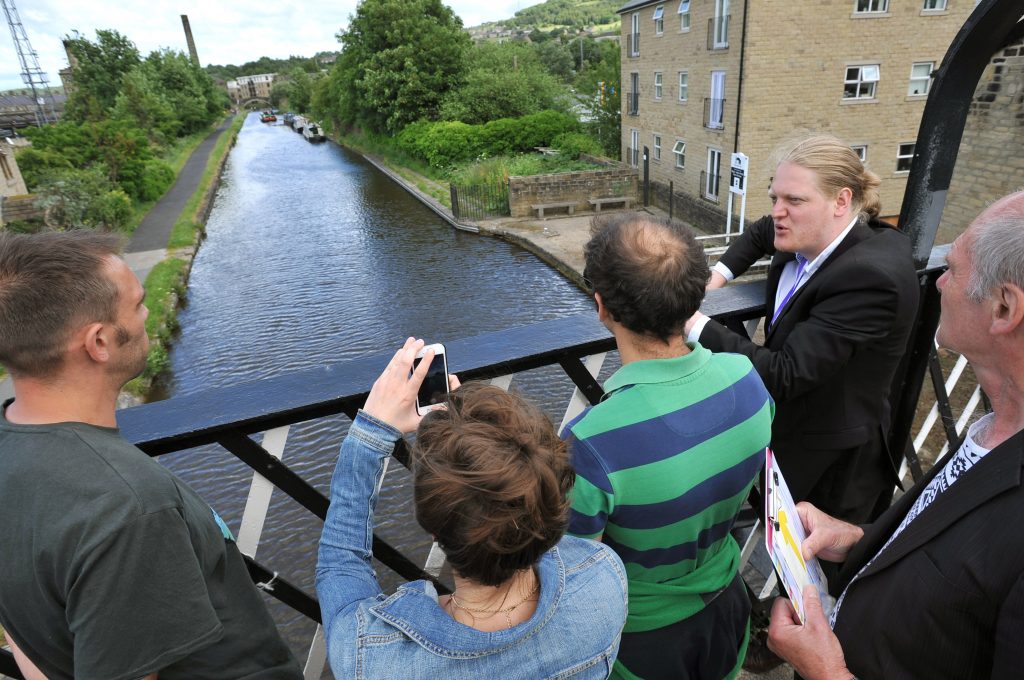
Descending from the bridge again, participants continue further along the canal — walking right over Bradford Beck on their way towards our fourth bridge, Junction Bridge — the cobbled, humpbacked bridge visible in the picture below (and, just about, in the one above!). Along the way, walkers continue — also — to search for the locations of their polaroid pictures, and to identify further locations to attach their wool…
At Junction Bridge, walkers are greeted by our third performer, Lynsey Jones. It is quickly evident from her costume and speech that she is in the past — 1872 to be precise. She is, she explains, the wife of the lock-keeper for Lock 1 of the Bradford Canal. Their cottage is just a few yards up the road on Dock Lane, because the junction for which Junction Bridge is named is the point at which the Bradford Canal joins the Leeds-to-Liverpool Canal. The bridge was built at the same time as the canals themselves, in the early 1770s, for horses to cross from one towpath to the other.
Lynsey’s character turns out to be something of an expert on the canalside plants and weeds we have passed on our journey — which she knows how to use for various medicinal and perfuming purposes (Lynsey had put some real research into this). And today is a big day from a health and wellbeing perspective, she explains, because we’re celebrating the re-opening of the Bradford Canal after five years of closure! It had had to be shut down because the water in the canal was so filthy and polluted it was a public health hazard, but now — thankfully — they’ve engineered a new solution to this problem by creating a pumping system that recirculates water back up the Bradford canal from the Leeds-Liverpool junction…
Of course, in present reality, it’s immediately clear to walkers that the Bradford Canal no longer exists — except as a stubby dead end here at the junction. Nevertheless, having pointed out our fifth bridge in the distance (the Dock Lane swing bridge, visible up ahead in the picture above), Lynsey directs spectators across Junction Bridge and up along the Bradford Canal, away from the Leeds-Liverpool… This entails us crossing around the filled-in mouth of the canal and under the bridge #6 — the railway bridge that crosses Dock Lane — and then continuing up Dock Lane as far as the old pump house, which opened in 1872 to perform the function Lynsey has described…
In the grounds of the pumphouse, walkers are met again by Simon and David (now in hi viz steward vests, having changed out of their character costumes), and invited to feed back on their journey…
Welcome to the Pump House!
- Did you find the location of your photo along the way…?
- See if you can match it with one of the luggage tags on the map – check the back of the luggage tag to see if the raffle tickets match. [the polaroids all had raffle stubs matching with the numbers on these location tags]
- Please pin the photo around the edge of the map, using the wool attached to the tag to connect it with its location.
Once you’ve attached your photo…
- Take a blank luggage tag from the table.
- Think back to the 3 locations you marked. Which struck you the most?
- Write or draw something on the luggage label to express how the location struck you.
- Pin the luggage tag to the appropriate location on the large map, as accurately as you can remember.
- Help yourself to a drink and await further instructions – you will be gathered for the next part of the experience.
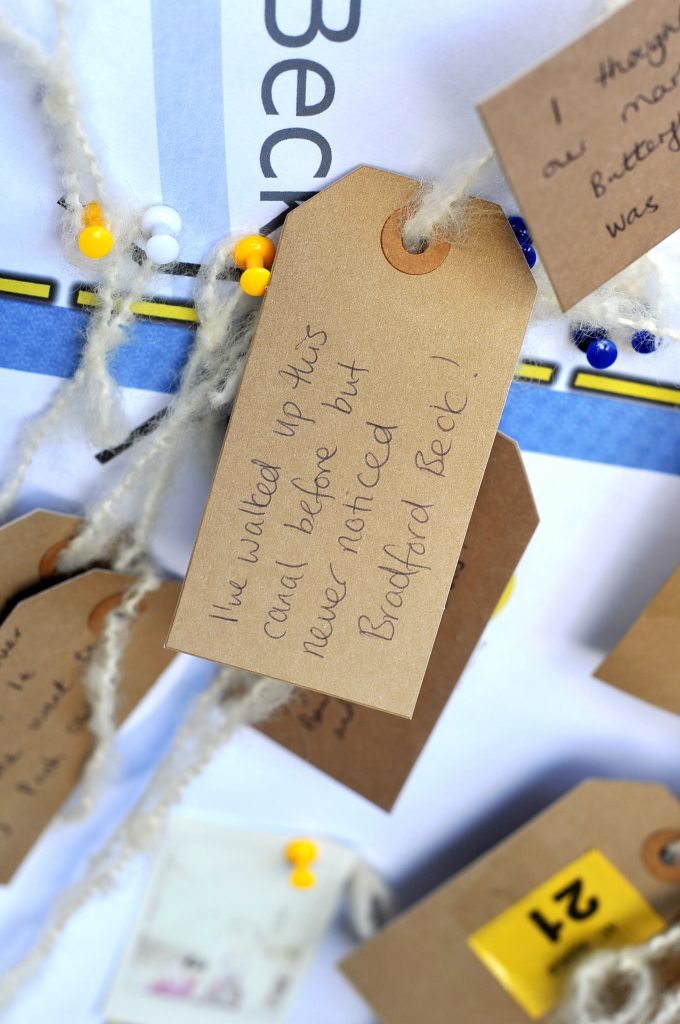 From this pumphouse hub, participants were now “recycled” back along the route they had already walked, to their starting point at Shipley Wharf (we thought of the journey as a kind of palindrome – there and back). On the return journey, they were accompanied by the performers — no longer in character — who each carried a Fujifilm camera, handing it out as necessary so that each participant could take a single exposure. The picture they chose was of their personal favourite location from the three they had earlier wool-tagged… and these were then used in the envelopes given to the subsequent participants at the start of their walks.
From this pumphouse hub, participants were now “recycled” back along the route they had already walked, to their starting point at Shipley Wharf (we thought of the journey as a kind of palindrome – there and back). On the return journey, they were accompanied by the performers — no longer in character — who each carried a Fujifilm camera, handing it out as necessary so that each participant could take a single exposure. The picture they chose was of their personal favourite location from the three they had earlier wool-tagged… and these were then used in the envelopes given to the subsequent participants at the start of their walks.
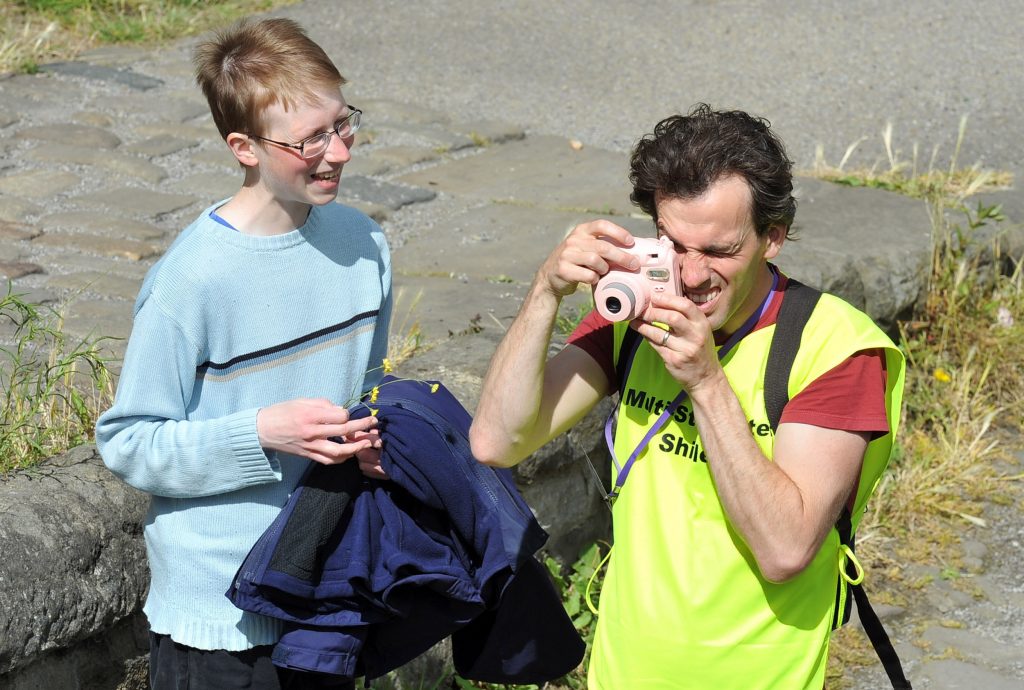 And so we retrace our steps, looking at the same scene in reverse — pausing to discuss the spots we chose to tag, and why, and sharing our thoughts and memories about the land- and waterscape around us… The actors are out of character now, unscripted, just conversing as we walk — but with certain gentle prompts for conversation so that there’s no danger of things ‘drying up’… It’s a period of sharing and reflecting in the sunshine.
And so we retrace our steps, looking at the same scene in reverse — pausing to discuss the spots we chose to tag, and why, and sharing our thoughts and memories about the land- and waterscape around us… The actors are out of character now, unscripted, just conversing as we walk — but with certain gentle prompts for conversation so that there’s no danger of things ‘drying up’… It’s a period of sharing and reflecting in the sunshine.
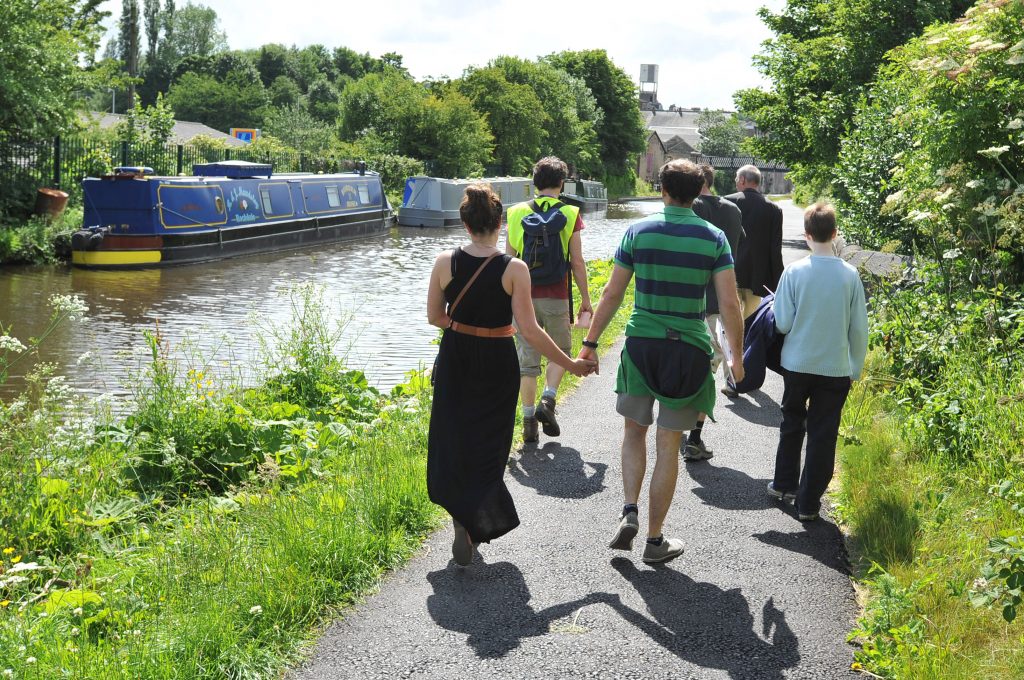 Seven Bridges (Shipley) was a gentle, thought-provoking experience – an experiment with walking through time and space. It was not necessarily everyone’s cup of tea, of course: if you came expecting a full-on, narrative-driven performance (perhaps like our earlier Multi-Story Water tours) you might have been disappointed by the fact that there were just three, fairly short monologues (future, present, past) punctuating a non-guided tour along a straight stretch of canal. But if you embraced the experience as a participatory journey in which you “filled in the blanks” for yourself, there was — I think — something rather magical about it…
Seven Bridges (Shipley) was a gentle, thought-provoking experience – an experiment with walking through time and space. It was not necessarily everyone’s cup of tea, of course: if you came expecting a full-on, narrative-driven performance (perhaps like our earlier Multi-Story Water tours) you might have been disappointed by the fact that there were just three, fairly short monologues (future, present, past) punctuating a non-guided tour along a straight stretch of canal. But if you embraced the experience as a participatory journey in which you “filled in the blanks” for yourself, there was — I think — something rather magical about it…
I can say that honestly (‘I’ being project manager Steve Bottoms) because while I had commissioned this piece from Simon, Lynsey and David, I was very little involved in the making of it, since I was preoccupied with making the partner piece for Leeds. So when I walked the route myself, I experienced it much as any other “punter” did — and found myself surprised and moved by the simple invitation to tune my senses in to what was around me. What could I see and hear, touch and smell? What would I tie my hank of wool to, and why? What bits of the past are still present here? And how might this present, now, be recognisable in the future? The canal provides a green and blue corridor of continuity through Shipley’s post-industrial landscape, and through time itself…
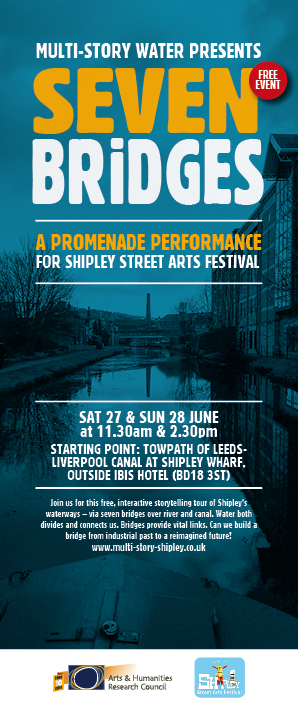 Seven Bridges (Shipley) was devised and performed by
Seven Bridges (Shipley) was devised and performed by
Simon Brewis, Lynsey Jones and David Smith,
with design input from Ellie Harrison,
and research/dramaturgical input from Steve Bottoms.
Flyer and logos designed by John Polley.
With special thanks to Natasha Glew and Q20 Theatre.
Text of our information sheet on the Seven Bridges encountered en route:
| 1. Otley Road. Although there has always been a bridge across the canal at this point, the current one does not have an agreed name. Some people call it Otley Road bridge. Some call it Shipley Bridge. But it’s almost as if the road is now so dominant, that it has forgotten there is a canal here to bridge… |
| 2. Gallows Bridge. The current iron and stone structure dates from the first half of the 19th Century, as do the stone cottages and former textile workshops on the south bank. However, there appears to have been a bridge at this location ever since the canal was built in 1774. The little landing platform, Gallows Wharf, used to be a stop for the local waterbus. |
| 3. Canal aqueduct. The Leeds-Liverpool Canal here passes effortlessly across the Bradford Beck. The Beck is made up from the water of many smaller becks that come together around Bradford, and flows into the River Aire just yards downstream from here. It is walled away because, in the past, it was treated as little more than an open sewage drain. |
| 4. Junction Bridge. One of the oldest bridges on the Leeds-Liverpool Canal, this stone-built structure dates back to 1774, and permitted tow-horses to pass across to the towpath of the Bradford Canal, which opened around the same time. The earliest cargoes on the Leeds-Liverpool were those moving between Skipton and Bradford, via this junction here. |
| 5. Dock Lane Swing Bridge. The relatively modern structure replaced an earlier swing bridge at this spot. Boaters need a crank handle to open it, and must turn it 18 times to fully open and close the bridge. Dock Lane is so-called because there used to be a dry dock for barges southwest of the bridge. |
| 6. Railway bridge over Dock Lane. This bridge carries the Aire Valley line from Leeds to Skipton (though another line forks off to Bradford, just above the Beck by McDonalds). From the mid-19th Century on, railways began to replace canals as the principal method for hauling industrial freight, although the Leeds-Liverpool Canal Company remained profitable well into the twentieth century. |
| 7. Pumphouse garden bridge. You can still see the outline here of the former lock chamber – Lock 1 of 10 on the three miles of the Bradford Canal. However, the white railings of the ‘bridge’ here are entirely fake, a garden ornament put in by the former owners who turned the pumphouse into a residence. The pumphouse is currently owned by Bradford Council, who kindly granted us access. |

